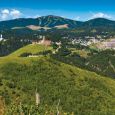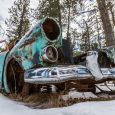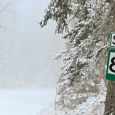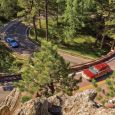The Gift of South Dakota
Subscriptions to South Dakota Magazine make great gifts!
Subscribe today — 1 year (6 issues) is just $29!
Prospecting in the Hills
 |
| Gary Mallams and fellow miners welcome opportunities to introduce youth to the adventure and intrigue of prospecting. |
“We never sell the gold,” Kathleen Flanagan, secretary of the Black Hills Prospecting Club, tells me over lunch in Rapid City. “It’s the first question everyone asks.”
This doesn’t make much sense to me. Why else would someone go out panning for gold?
And then the members of the club bring out their favorite nuggets. Almost all of them have brought their best finds to lunch. Most are kept in small vials filled with water or mineral oil.
As I rotate the vials, nuggets and flakes roll around, catching light as only gold does, and these prospectors’ reluctance to sell their gold suddenly seems reasonable. Money all looks the same. Sell a gold nugget and you’re trading something unique for plain old folding money, and eventually whatever ordinary goods that money can buy.
People used gold for decoration long before they used it for money, and if you’ve seen unprocessed gold sparkle, a little bit of that fascination probably rubbed off on you.
For many club members, their love affair with gold started at an early age. Lou Schmeltzer, one of the older members of the club, can still remember the day 80 or so years ago when one of his father’s friends brought white quartz crystals embedded with gold into his father’s barber shop in Lead, along with pieces of schist that had free gold between the layers. He still has some of those pieces of schist.
By age 9, Schmeltzer was sneaking off into the abandoned mines around Lead, looking for gold with a candle in his hand. Later, equipped with one of his mom’s pie pans, he set about panning for gold wherever he found a ledge, or outcrop, of mineralized rock that might have deposited gold into a streambed as it slowly eroded. Finally he got an authentic prospector’s pan — a banner day indeed.
The process of panning for gold hasn’t changed much since the Deadwood gold rush of 1876. Prospectors start with placer deposits, which are basically old streambeds. They’re a mix of loose soil and gravel that eroded from the Black Hills eons ago and washed down into valleys, where it remains.
 |
| Deadman Gulch, buried deep in the Black Hills near Rockerville, is a popular claim site for Don Hamm and fellow members of the Black Hills Prospecting Club. The gulch was named for two miners who died there in 1876. |
A prospector starts with a pan full of water and placer material dug from a nearby deposit or scooped from the streambed itself. By carefully swirling the water around and allowing it to spill out of the pan, loose soil and lighter rocks are washed away, leaving the densest minerals, often a dark gray to black mass. If there’s any “color” in there (yes, prospectors still call it that), it will appear right along the curve. Sam Griner, a veteran prospector, calls it “a big smile at the bottom of the pan.”
Panning equipment has been upgraded slightly, even if the process is little changed. Rather than sturdy metal pans, today’s prospectors often prefer pans made of soft rubber that can be twisted and bent to better control the water swishing around the bottom. Pans are usually dark in color to make it easier to see small flecks of gold.
Some prospectors also use a sluice box, a long trough that has various ridges that catch rocks and minerals as water runs through it. The principle is basically the same as panning — gold is heavier than almost any other rock or mineral likely to turn up in a placer deposit, and it will settle to the bottom of the sluice box, while the water washes loose soil and lighter gravel away.
Although prospectors are looking for gold, it’s not unusual for other minerals to show up at the bottom of the pan. The Black Hills have a little of everything, including gems and metals. Don Hamm, the club’s vice president, once found a small platinum nugget while panning, and several other prospectors have found tourmaline and gem quality garnets. In fact, the January birthstone is so plentiful in the Hills that one of the club’s claims is called the Garnet.
The suspense of panning, of not knowing what you’re going to find, is part of what makes it an enjoyable hobby. “It’s all about the hunt,” according to Dean Duncan, “and the sense of satisfaction in finding the first piece of the day.”
“You can learn a lot of patience and a lot of frustration,” says Sam Griner. “But it’s all fun,” he continues, because when some color does turn up, “you’re the first person to ever see that nugget of gold.”
Stewardship of the land is an important part of panning. Prospectors during the gold rush weren’t so concerned about leaving a claim in better condition than they found it, but it’s a point of pride for many members of the club. If prospectors dig a hole in a placer deposit, they’re expected to backfill the hole and seed it with grass when they’re done. If they excavate loose deposits from a hillside, they’re expected to knock down the overburden, meaning to collapse the hillside over the excavation instead of leaving holes in the hill.
 |
| Club president Gary Mallams says, "finding gold in your pan is just one of the rewards for being in a beautiful place with good friends." |
Panning on National Forest land still occurs on claims, and while a few members of the Black Hills Prospecting Club also work their own claims, most of them work on one of five claims that the club maintains. Two are along French Creek, where members of George Custer’s expedition discovered gold in 1874.
Don Hamm works his own claim. He and his father, Bob, the oldest member of the club at 92, may be the most experienced prospectors. In 1982, they incorporated themselves as “Southern Hills Mining” and had the third largest gold mining operation in South Dakota that year. They pulled about 50 ounces of gold out of a placer deposit from one of Don’s secret spots.
The land under most claims remains the property of the federal government. Prospectors are free to take the gold they find, but they don’t have any other ownership stake in the land. However, some claims are “patented,” meaning that the claim belongs to the claimholder. He can build a mine — or even a house — on the land. Lots of private property in the Hills started out as patented claims.
Don Hamm lives on a patented claim along Deadman’s Creek. That inspired his grandkids to try prospecting. “You dig in the dirt and you can usually find gold,” he says. “It’s fun to teach the kids how to pan — once they find gold, they’re hooked.”
Kathleen Flanagan’s daughter, Kristin Draine, and her husband Chris are also active in the Prospecting Club. Like most members, they have a stock of nuggets found while panning.
However, they have an additional reason for being involved. “It’s something we want for our kids,” Kris says, “to be out in nature and active, not always inside.” Of course, many youth are skeptical at first. Venturing into the Hills to slosh water and dirt around in a rubber plate may not sound like fun. But many kids change their minds when they start finding gold. “Are we going prospecting this weekend?” is now a common question in the Draine household.
There’s also a social aspect to prospecting. Membership in the Black Hills Prospecting Club is just over 250 from several states, and they have regular monthly meetings and organized outings and contests. The current record holder in their panning contest is a man from Keystone who sifted through a pan in only 12.5 seconds.
Dean Duncan talks about the enjoyment of being out with friends, and “showing the greenhorns how to pan and some of the shortcuts and tricks.”
Club president Gary Mallams agrees. He discovered prospecting on a trip to Alaska, and while he enjoys the search as much as anyone in the club, “finding gold in your pan is just one of the rewards for being in a beautiful place with good friends.”
It doesn’t hurt that the prospecting takes place in the Black Hills. For many, the scenery is worth the trip, even when the prospecting doesn’t go their way. Larry Howells moved into the Hills from Kansas. He thought that panning would be an “easy, fun hobby with some financial return.”
 |
| Veteran prospectors say the gold flakes they find are, "a big smile at the bottom of the pan." |
It didn’t work out that way. “I soon found out that carrying a pick and shovel, packing buckets of rock and dirt, standing in cold water, and swirling several pounds of mud and gravel in a pan is not easy.” Regarding the financial return, he says, “Don’t quit your day job.”
But he’s still an active member. “Fun comes from being out in some of the most breathtaking scenery and the sounds of nature.”
“I’d heard of the Hills,” says Bill Dore. “I was working out in the eastern Montana oil fields in the early ’80s, in the summer heat, just baking, and I used to dream about going up some creek with a pan — and who knows what I’d find? I just wanted to be out in the shade. That’s a lot better than the Montana oil fields.”
There’s great value in prospecting deep in the Black Hills, but these days it has little to do with the price of gold.
Editor’s Note: This story is revised from the March/April 2017 issue of South Dakota Magazine. To order a copy or to subscribe, call (800) 456-5117.










Comments
Can this issue be purchased. Muyyay